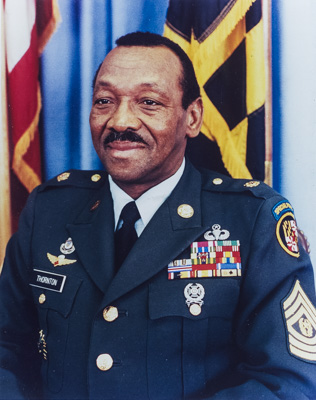A look at black history in the Maryland Guard: retired Command Sgt. Maj. Wilson J. Thornton Jr.
[vc_row][vc_column][vc_video link=”https://www.youtube.com/watch?v=OtCu3wLcOmM”][vc_column_text]
By Staff Sgt. Thaddeus Harrington, 29th Mobile Public Affairs Detachment
BALTIMORE (Feb. 4, 2014) – In 1776, Congress passed legislation allowing black men to enlist in the armed services. Following that decision, approximately 7,000 black men enlisted in the Army to defend America during the Revolutionary War. Throughout the nation’s history, they continued to play significant roles in the U.S. military.
In 1863, President Abraham Lincoln’s Emancipation Proclamation declared freedom for slaves in states not under Union control, allowing blacks to fight for the Union. That same year, the 19th Regiment Infantry, U.S. Colored Troops, Maryland Volunteers was formed in Benedict, Md. The 19th was comprised of a mixture of free blacks and of slaves purchased by the U.S. government for their freedom and service as Soldiers.
In 1866, Congress authorized six segregated regiments of Soldiers who later became known as the “Buffalo Soldiers.” There were several all-black units in the Army, which included the 555th Parachute Infantry Battalion “Triple Nickels,” the 758th Tank Battalion (Light) “Tuskers,” and the 2nd Ranger Infantry Company (Airborne) “Buffalo Rangers,” among others.

“We didn’t realize that the Army was really segregated, because we thought it was the norm,” said retired Command Sgt. Maj. Wilson J. Thornton Jr., the first black state command sergeant major of the Maryland National Guard. “At Fort Benning, Ga., we actually went through separate serving lines at the dining hall.”
In 1948, President Harry Truman signed Executive Order 9981, stating, “There shall be equality of treatment and opportunity for all persons in the armed services without regard to race, color, religion or national origin. This policy shall be put into effect as rapidly as possible, having due regard to the time required to effectuate any necessary changes without impairing efficiency or morale.”
“There were some advantages to being in a segregated unit,” added Thornton, “because you didn’t have to compete for rank Army-wide. All you had to do was be better than the guys in your unit.”

Thornton was a member of the 231st Transportation Truck Battalion, now the 229th Main Support Battalion. The 231st can trace its lineage to an 1879 all-black independent city militia company in Baltimore, “The Monumental City Guards.” The unit was accepted into the Maryland National Guard as an infantry company in 1882 and redesignated the 1st Separate Company.
In 1946, the unit was reorganized and federally recognized as Headquarters and Headquarters Detachment, 231st Transportation Corps Truck Battalion, with responsibility for three truck companies. On Aug. 19, 1950, the 231st mobilized to serve in Korea and became the only Maryland National Guard unit ordered to active duty to support the Korean War.
During wartime, the 231st served as an integrated unit. Upon its demobilization and return to Maryland, many 231st officers refused to serve in a segregated unit. In November 1955, Gov. Theodore McKeldin issued an order to end racial segregation in the Maryland National Guard, making Maryland the first state below the Mason-Dixon Line to integrate its National Guard.
During the civil rights movement of the 1960s, Maryland Guard members were called on to help contain disturbances throughout the state. In September 1963, then Sgt. 1st Class Thornton and his unit were sent to Cambridge, Md., during the rioting.
Thornton recalled a moment when an activist met with Maj. Gen. George Gelston, who was the equivalent of a task force commander during the 1963 riots, and told him that his troops were segregated and they had nothing more to discuss.
“He [Gelston] turned around and told the battalion commander to ‘get this thing straightened out right now!’” recalled Thornton.

“At that point, that battalion integrated. All the assignments from that point on were integrated assignments with mixed troops at all the duty stations and duty points,” said Thornton. “That was the first integration that I experienced in the Maryland Guard.”
This look at black history within the Maryland National Guard is a part of a series. The assembly of content used in this series started in 2013.
[/vc_column_text][/vc_column][/vc_row]
